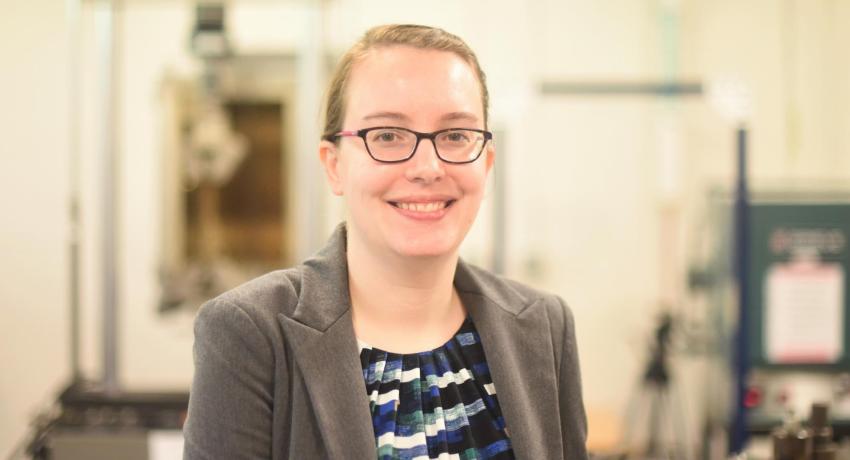Beth Last, the research core facilities coordinator at Penn State Behrend, is the co-principal investigator for a $385,000 National Science Foundation grant at the college. Credit: Penn State Behrend / Penn State.
ERIE, Pa. — A $385,000 grant from the National Science Foundation will fund the purchase of an Instron drop tower impact-testing system at Penn State Behrend, where faculty members are developing new approaches to polymer recycling and the formulation of new composites.
At least 10 faculty members will use the system to advance their research, which includes automotive and aerospace partnerships. Another will use it to test new polymers for ski boots and bindings.
The Instron system will expand the materials research capabilities at Behrend, where grant funding and industry partnerships fueled $8.3 million in research expenditures in 2021.
“This takes us into a whole new kind of materials science,” said Greg Dillon, chair of the Polymer Engineering and Science program at Behrend and the principal investigator for the NSF grant. “It allows us to delve very deeply into fracture mechanics: how materials and structures fail under high energy.”
Drop towers are used to determine how materials break. The drop mechanism, or tup, is fired like an arrow into a plastic, metal, ceramic or gel. The Instron tup drops at a rate of 78 feet per second.
“It’s a lot like a crossbow,” said Alicyn Rhoades, the interim associate dean for research and graduate studies at Behrend. She and Dillon wrote the original application for the NSF grant.
For a previous study, during a sabbatical, Rhoades used a drop tower owned by a corporate partner. The tup on that machine had been customized for the company’s product, however, so it was not practical to collaborate on the machine for University projects.
Rhoades and Dillon began the process of acquiring a drop tower at Behrend. The Instron system they selected will include a variety of tups — round, flat and conical — that can be changed based on an individual researcher’s needs. The conditioning chamber can be heated or cooled to test how a material responds at different temperatures, from a high of 302 degrees Fahrenheit to a low of -94 degrees.
“Any time you test, you want to do so in conditions that are as close to the actual product environment as possible,” said Beth Last, the research core facilities coordinator at Behrend and the co-principal investigator for the grant.
Automotive plastics, for example, have to retain their properties over a range of temperatures. In an engine compartment, the temperature can exceed 200 degrees. In the bumper, in winter conditions, it can dip below zero.
At low temperatures, plastics become brittle and are more likely to break.
“With polymers, the mystery of fracture mechanics is that it’s so difficult to understand all the phases of the event,” Rhoades said. “We generally know when a material is going to fail. But too often, after that happens, we’re left looking for clues on the surface of the sample, trying to trace back to the origin of the fracture.”
A high-speed camera on the Instron system will allow Behrend researchers to analyze the entire process. The camera, which can be set to different magnifications, can record 900,000 frames every second.
Like a Harold Edgerton photo — the bullet piercing the apple, or the splash of milk forming a perfect white crown — those images essentially stop time: Researchers can see the exact moment a crack or fracture forms. Then, a few frames ahead, they can watch it spread.
“You can see what’s happening within the material,” Dillon said. “Is it bending? Does it deform? Does it in any way resist the impact? Once you know that, you can engineer materials that better absorb that energy.”

